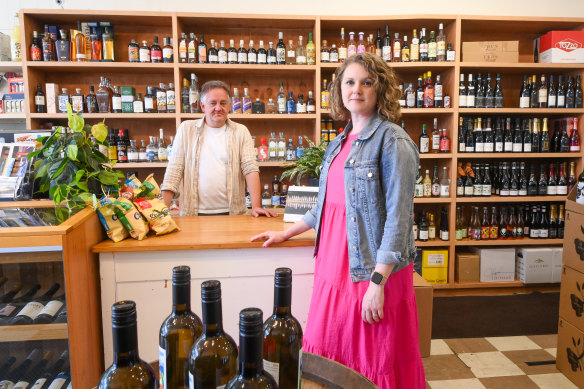Save articles for later
Add articles to your saved list and come back to them any time.
Key points
- Shop owners in Melbourne’s beachside suburb, Williamstown, are closing their doors as trade lags on the once-busy shopping strips.
- According to Hobsons Bay Council’s estimates, current retail vacancy rates are estimated to be 14.7 per cent in Douglas Parade and 13.8 per cent in Nelson Place.
- Hobsons Bay Council has enlisted the help of Renew Australia, a non-profit group, that places creatives in empty shops and negotiates 30-day rolling licences with landlords to inject liveliness into ailing shopping strips.
- Renew Australia recently worked with The City of Port Phillip to revitalise Fitzroy Street at a cost of $450,000 across three years.
The once-lively Williamstown has been forced to bring in consultants to help stop an exodus of businesses and plummeting sales in the beachside shopping strips.
In October, three restaurants shut up shop in the same week. A fourth went a week later.
Justin Bell, owner of Williamstown Fine Wines and Megan Walls, owner of Dogtown Pet Supplies, both have businesses located on Ferguson Street, Williamstown.Credit: Justin McManus
In Williamstown, the three main shopping strips are on Nelson Place, Ferguson Street and Douglas Parade. Like other once-lively suburban strips, the beachside suburb in Melbourne’s south-west is losing businesses to high rent, low foot traffic and a lack of parking.
Williamstown Fine Wines owner Justin Bell, who has been located on Ferguson Street for 27 years, said he’s never seen anything like it.
“It’s worse than during COVID,” Bell said. “It’s been a very quiet year.”
Bell said he paid $5200 a month – $500 more than he did in 2018/19 – for his 88 square metre shop.
“Commercial rents in Williamstown are too high for the amount of money businesses can make, because it’s only serving locals,” he said. “There are other traders that have seen really big rent jumps.”
All three of Williamstown’s shopping strips have either paid parking or free limited-time parking, but traders argue it’s not enough for the area.
Bell said the lack of pick-up and drop-off parking turned customers away.
“I’ve had customers do laps around the street to find parking and tell me they’ve given up on coming in to buy something because of it,” he said.
According to Hobson Bay Council estimates, current retail vacancy rates in Williamstown are 14.7 per cent in Douglas Parade, 13.8 per cent in Nelson Place. Businesses have also left Ferguson Street, but its vacancy rate is only 1.6 per cent, according to the council.
Data from property consultancy Plan1 suggests Melbourne retail vacancy rates are still sitting around 10 per cent with places such as Bridge Road and Chapel Street higher at 20 per cent.
“Some areas have recovered better than others, as a result of COVID, consumer patterns of working, living, and commuting has changed,” Plan1 director Richard Jenkins said.
In Williamstown last month, the Rose Hotel, the Morning Star Hotel and Croatian restaurant Ragusa all shut. Sideshow Bob’s Burgers also closed at the same time, but said it was due to a “management issue” and has since reopened.
Vietnamese restaurant Ms Kim in Nelson Place – owned by My Kitchen Rules finalist Kim Tran – closed earlier in the year. The restaurant said it was due to its rent costs skyrocketing to $100,000 a year and council rates jumping from $10,000 to $12,000 in the past few years.
To tackle the issue, Hobsons Bay Council enlisted not-for-profit Renew Australia to examine Williamstown’s shopping strips and come up with a plan to increase foot traffic and reverse vacancy rates.
Renew Australia’s strategy involves placing start-ups, not-for-profits and social enterprises in empty shops and negotiating 30-day rolling leases with landlords to inject liveliness and increase foot traffic. The group recently did this in Fitzroy Street, St Kilda and Docklands.
Jaclyn Pokrovsky, a consultant at Renew Australia who worked on the scoping and feasibility study of Williamstown, said the low foot traffic, current cost of living crisis, low spending and changing demographics in the area were contributing to its issues.
In St Kilda, the group worked with the City of Port Phillip and Fitzroy Street Business Association on a three-year project to fill empty shops.
Fitzroy Street, St Kilda was part of a recent revitalisation project costing $650,000.Credit: Chris Hopkins
Port Phillip Council Mayor Heather Cunsolo said the project – which will end in December – was a success, with five participants deciding to stay and developer Fortis earmarking 63 Fitzroy Street for the construction of a mixed-use building.
But the project came at a cost of $450,000 across three years, with the Fitzroy Street Business Association and council sharing the cost.
Williamstown Chamber of Commerce president Rosemary Angyasy said the group did not have the money to spend on a revitalisation project.
Angyasy said some of the issues plaguing Williamstown were not new – including paid parking, strict planning regulations around Nelson Place and poor lighting – and traders had raised these before.
“While we understand things take time…some traders don’t have the time to wait.”
The ongoing West Gate Tunnel roadworks had also affected businesses in Williamstown, Angyasy said.
“Williamstown has many hidden gems but crossing the bridge to get to them is a time-consuming effort that never seems to end.”
Hobsons Bay Council declined to say how much the council was willing to pay for a revitalisation project.
“We are still considering several options to revitalise Williamstown, including a project to activate vacant shopfronts,” a spokesman said.
Get the day’s breaking news, entertainment ideas and a long read to enjoy. Sign up to receive our Evening Edition newsletter.
Most Viewed in National
From our partners
Source: Read Full Article

